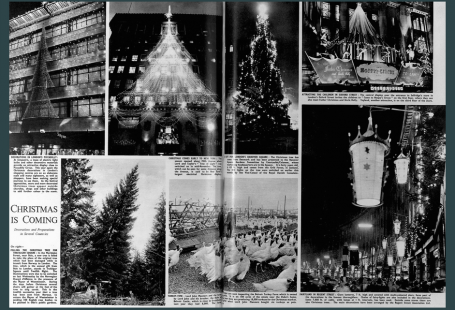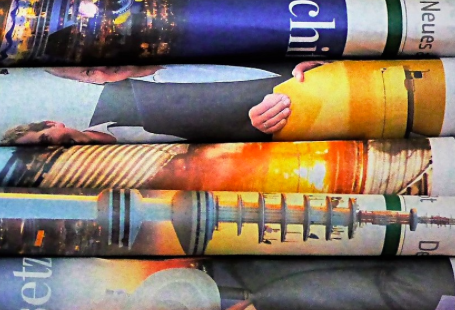From April this year our long-term partner the British Library has been home to a fantastic exhibition – Breaking the News – which investigates the ‘big questions about the news we consume.’ Exploring how the news shapes the world around us, the exhibition combines different news mediums from five centuries, from radio to television, from pamphlets to newspapers, as well as using objects and artefacts from the British Library’s extensive collection.
Book your tickets for the Breaking the News exhibition here
And some of the newspapers from the Breaking the News exhibition are available to view as part of our collection here at The Archive, and without giving anything away from the exhibition, we’ve highlighted a few of them in this special blog.
Meanwhile, one of the curators of the exhibition, Luke McKernan, who is the Lead Curator, News and Moving Image at the British Library, told The Archive how:
Although the exhibition has many different kinds of news publications, from television news to newsreels to social media, around half of the objects on display are newspapers. The grid-like structure employed as part of the exhibition design echoes the newspaper form; the labels have newspaper-like headlines.
Newspapers are a vital part of the exhibition, therefore, and are vital to how we perceive the news today. Luke McKernan adds how:
Newspapers still define our idea of what makes the news. The commanding authority of the masthead; the use of eye-catching headlines; the way different stories are arranged on a page, inviting us to scan the latest information in all its compelling variety – newspapers are designed to convey the importance of news. The also exemplify its ephemerality, as what is important now, once read, is folded up and discarded. Then we wait for the next day’s news to arrive.
So what newspapers can you expect to find in the exhibition that are also available to view on The Archive? Here are six newspapers from the Breaking the News exhibition that you can browse as part of our collection.
Register with us now and see what stories you can discover
1. Illustrated Police News

Part of the Breaking the News exhibition examines sensationalism, and how it has been a mainstay of the news media for centuries. And one of the most sensationalist newspaper titles ever published was the Illustrated Police News, which was established in 1864.
Dubbed the ‘worst newspaper in England,’ the Illustrated Police News was founded by George Purkess (1840-1892), who maintained that he wanted to raise awareness of both the dangers and the consequences of crime. However, his newspaper title, with its bold and lurid illustrations, its melodramatic reporting, served to capitalise on the British public’s appetite for sensationalism.
You can browse the pages of the Illustrated Police News here – The Archive holds the years 1867-1938 of this weekly title.
2. Daily Mirror

An exhibition on news would not be complete without one of the United Kingdom’s national papers, and indeed the Breaking the News exhibition features several national newspaper titles, one such being the Daily Mirror, which is also available to view on The Archive.
Founded in 1903, and originally targeted at a female audience, the Daily Mirror is the longest-running tabloid in Britain. Not immune itself to scandal, and scandal is something that the exhibition puts under the microscope, the Daily Mirror is famous for holding a centre-left political view and for its support of the Labour party.
Also on view at the exhibition is the Mirror Photo Censor Book. This book is an amazing record of which photographs were permitted for publication and which were blocked by the Ministry of Information during the Second World War.
At one time the world’s best-selling newspaper, reaching daily sales of five million copies, you can view the Daily Mirror here, with a complete run of the title all the way from 1903 to 1999. You can also access its sister title, the Sunday Mirror, which was originally known as the Sunday Pictorial, on The Archive too.
3. Illustrated Sporting News and Theatrical and Musical Review

From sensationalism to scandal, the Breaking the News exhibition also looks at how events are celebrated by the news media. Such celebrations often revolve around the sphere of sport, and the exhibition includes an excerpt from early sporting title the Illustrated Sporting News and Theatrical and Musical Review.
Launched in 1862, the Illustrated Sporting News and Theatrical and Musical Review capitalised on the British public’s growing appetite for sporting news. The Illustrated Sporting News and Theatrical and Musical Review obliged, featuring articles on everything from football to golf, from boxing to pedestrianism (a favourite pursuit of the nineteenth century), alongside wonderful wood engravings.
What’s more, you can view the Illustrated Sporting News and Theatrical and Musical Review here as part of our free to view collection on The Archive. Its digitisation has been made possible as part of the British Library’s Heritage Made Digital programme, which focusses on making British Library collections available online and the improvement of digital access generally.
4. Berthold’s Political Handkerchief

Forming part of the exhibition’s examination of what makes a free press is unique title Berthold’s Political Handkerchief, the digitisation of which has also been made possible by the Heritage Made Digital programme.
Printed in 1831 on calico to get round the infamous newspaper stamp tax, the Political Handkerchief seemed to be an inspired marketing ploy, its first edition declaring how ‘a piece of printed cotton may be read and then used for a thousand different purposes.’ This wonderful artefact, in all its cotton glory, is available to view at the Breaking the News exhibition.
However, its publishing run was short-lived. Only lasting for ten or so editions, its founder Henry Berthold was ultimately transported for theft. You can view editions of his Political Handkerchief here.
5. Manchester Guardian

In a similar crusading vein, the Manchester Guardian was founded in 1821 with the intention of prioritising facts above all. As part of the Breaking the News exhibition’s examination of news ethics, the Manchester Guardian is an example of a newspaper that was not tied to the establishment, which was highly unusual at a time when most newspapers were linked to a party or a cause.
In 1959 the Manchester Guardian became The Guardian, the national newspaper we are familiar with today. We have early pages from the 1820s from the Manchester Guardian available to view on The Archive here, including the newspaper’s first ever edition.
6. Pall Mall Gazette

The final newspaper we’d like to highlight from the Breaking the News exhibition is the Pall Mall Gazette. In 1885 the Pall Mall Gazette published a series of articles by editor W.T. Stead (1849-1912), which would both precipitate a change in law and a change in journalism. Stead’s articles addressed child prostitution in Britain, and were hailed as examples of ‘new journalism.’ They would lead ultimately to the age of consent in the United Kingdom being raised from thirteen to sixteen.
The exhibition highlights, therefore, this important milestone in investigative journalism. Indeed, Stead is also credited, through his work with the Pall Mall Gazette, with the introduction of the interview into British newspaper reporting. We have editions of the Pall Mall Gazette from its first publication in 1865, all the way through to 1925, available to view here on The Archive.
We hope we’ve whetted your appetite for this wonderful exhibition. It is on at the British Library until Sunday 21 August 2022, and for more information and to book your tickets please click here. With thanks to Luke McKernan for contributing to this blog.






